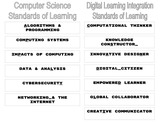
English Instructional Plan – Grades 9-12
- Subject:
- English
- Writing
- Material Type:
- Lesson Plan
- Author:
- VDOE Project Team
- Date Added:
- 04/22/2022

English Instructional Plan – Grades 9-12

English Instructional Plan- Comparative Analysis of Two Texts

English Instructional Plan Compare and Contrast Paired Texts 8-9

English Instruction Plan – 9-Compare and Contrast Texts

Comparing and ordering integers using a number line and using symbols. Mathematics Instructional Plans (MIPs) help teachers align instruction with the 2016 Mathematics Standards of Learning (SOL) by providing examples of how the knowledge, skills and processes found in the SOL and curriculum framework can be presented to students in the classroom.

Comparing two percents using representations and symbols and ordering positive rational numbers expressed as fractions (proper and improper), mixed numbers, decimals, and percents. Mathematics Instructional Plans (MIPs) help teachers align instruction with the 2016 Mathematics Standards of Learning (SOL) by providing examples of how the knowledge, skills and processes found in the SOL and curriculum framework can be presented to students in the classroom.

Comparing decimals and ordering up to four decimal numbers expressed through thousandths Mathematics Instructional Plans (MIPs) help teachers align instruction with the 2016 Mathematics Standards of Learning (SOL) by providing examples of how the knowledge, skills and processes found in the SOL and curriculum framework can be presented to students in the classroom.

Comparing Fractions. Mathematics Instructional Plans (MIPs) help teachers align instruction with the 2016 Mathematics Standards of Learning (SOL) by providing examples of how the knowledge, skills and processes found in the SOL and curriculum framework can be presented to students in the classroom.

Reasoning with benchmarks and other strategies to compare fractions. Mathematics Instructional Plans (MIPs) help teachers align instruction with the 2016 Mathematics Standards of Learning (SOL) by providing examples of how the knowledge, skills and processes found in the SOL and curriculum framework can be presented to students in the classroom.

Comparing Linear and Exponential ModelsMathematics Instructional Plans (MIPs) help teachers align instruction with the 2016 Mathematics Standards of Learning (SOL) by providing examples of how the knowledge, skills and processes found in the SOL and curriculum framework can be presented to students in the classroom.

Comparing and ordering whole numbers - Mathematics Instructional Plans (MIPs) help teachers align instruction with the 2016 Mathematics Standards of Learning (SOL) by providing examples of how the knowledge, skills and processes found in the SOL and curriculum framework can be presented to students in the classroom.

Compare numbers Mathematics Instructional Plans (MIPs) help teachers align instruction with the 2016 Mathematics Standards of Learning (SOL) by providing examples of how the knowledge, skills and processes found in the SOL and curriculum framework can be presented to students in the classroom.

English Instructional Plan Comparing and Contrasting Details in Texts 6 Primary Strand: Reading 6.5 Integrated Strand/s: Communication and Multimodal Literacies 6.1

Performing complex number arithmetic Mathematics Instructional Plans (MIPs) help teachers align instruction with the 2016 Mathematics Standards of Learning (SOL) by providing examples of how the knowledge, skills and processes found in the SOL and curriculum framework can be presented to students in the classroom.

This is a VDOE Webinar, Complexity for All: Scaffolding Academic Tasks, recorded on November 9, 2020.

Solving problems involving area and perimeter of composite figuresMathematics Instructional Plans (MIPs) help teachers align instruction with the 2016 Mathematics Standards of Learning (SOL) by providing examples of how the knowledge, skills and processes found in the SOL and curriculum framework can be presented to students in the classroom.

Exploring Composition of Functions Mathematics Instructional Plans (MIPs) help teachers align instruction with the 2016 Mathematics Standards of Learning (SOL) by providing examples of how the knowledge, skills and processes found in the SOL and curriculum framework can be presented to students in the classroom.

In this activity, students and teachers are able to sort components of a computer into 4 categories: input, output, process, and store (memory).
Reinforcing the ability to drag and drop, learners are able to identify and begin developing the purpose of each categorized component.
This activity complements the book Hello Ruby: Journey Inside the Computer by Linda Liukas and was remixed with permission from the San Francisco Unified School District (SFUSD) Computer Science Team.
Key concepts include:
mouse
keyboard
printer
microphone
headphones
monitor
controller
camera
temperature sensor
3-D printer
CPU
GPU
ROM
RAM
Hard Drive
Input
Output
Memory
Process

Students will explore computing parts and use oral language and content area vocabulary to describe items, then write a descriptive sentence to describe a technology problem.

This webinar is from February 23, 2023, featuring Keisha Tennessee and Calypso Gilstrap from VDOE's Office of STEM and Innovation. Objectives: Ensure understanding of the Computer Science (CS) and Digital Learning Integration (DLI) Standards of LearningProvide educators with a lesson example that addresses CS and DLI standardsDefine the instructional practice of integration and provide examples of CS and DLi integration Examples are related to Advanced AI and ChatGPT